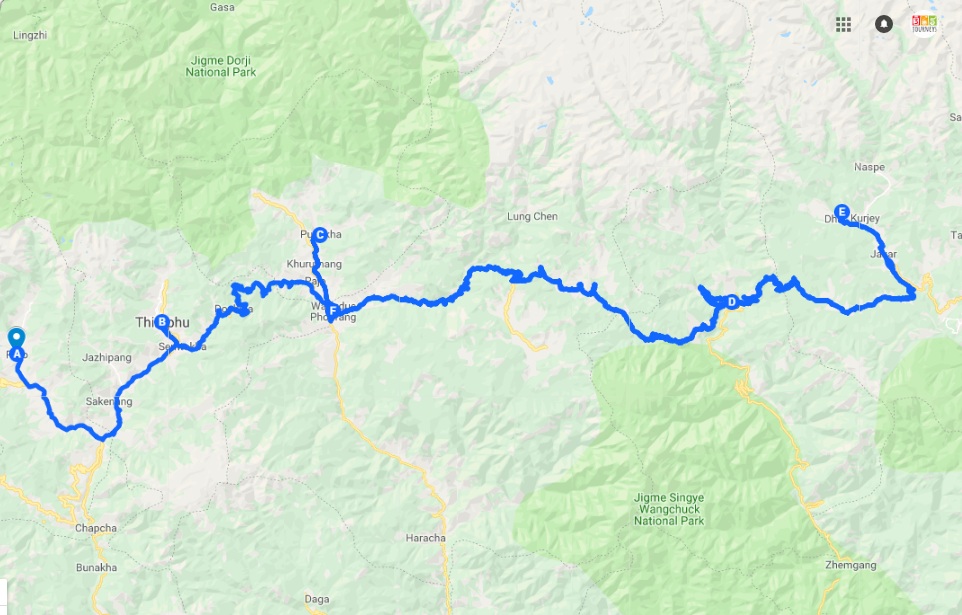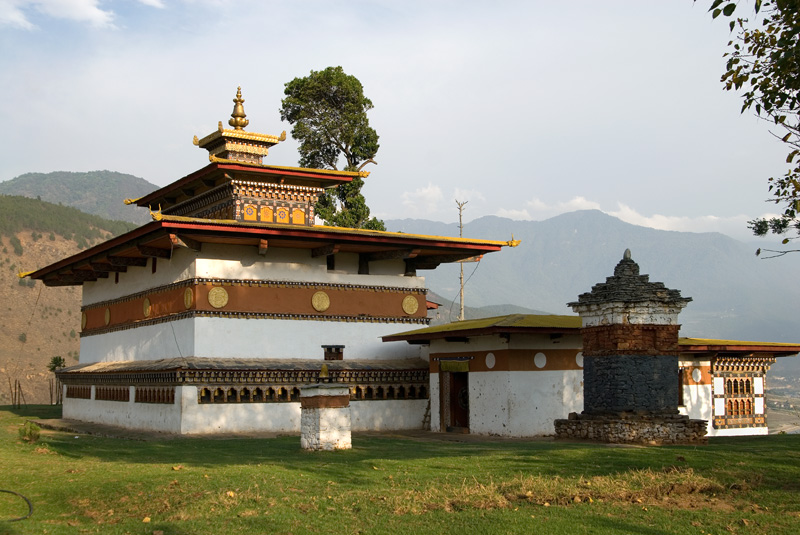Land of the Thunder Dragon
Land of the Thunder Dragon Destination Details
Paro Thimphu Punakha Trongsa Bumthang Wangduephodrang Paro
Popularly known as the ‘Land of the Thunder Dragon’, Bhutan lies between India and Tibet. This 9 days tour will give you a chance to see the mix of museums, mountain passes and ancient ruins. One can also explore the tradition and culture and besides this there lies a lot of mystery on this land to explore.
Guided tour of Punakha visiting the Punakha Dzong
Visit Jakar Dzong in Bumthang
Visit to Tiger’s Nest in Paro
January till December
Itinerary Highlights
Day 1 Arrive Paro – Thimphu (Drive 55 Kms, approx 1 hrs)
Arrive Paro Airport you will be received by our representative followed by an interesting drive of about 1.1/2 hours duration to Thimphu, the modern capital town of Bhutan.
Afternoon visit Memorial Chorten. This stupa was built in 1974 in the memory of Bhutan ‘s third King, His Late Majesty,King Jigme Dorji Wangchuk, who is popularly regarded as Father of modern Bhutan. The paintings and statues inside the monument provide a deep insight into Buddhist philosophy.
Later drive to visit Trashichhoedzong. Also know as ‘fortress of the glorious religion’, it was initially built in 1641 and later rebuilt in its present form by King Jigme Dorji Wangchuk in 1965. The Dzong houses, main secretariat building which houses the throne room of His Majesty, the King of Bhutan. The National Assembly Hall is housed in a modern building on the other side of the river from the Dzong. During the warmer summer months, the monk body headed by His Holiness, the Je Khenpo, makes its home in the Dzong.
Overnight Accommodation in Thimphu
Day 2 Thimphu
The capital town of Bhutan and the centre of government, religion and commerce, Thimphu is a unique city with unusual mixture of modern development alongside ancient traditions. Although not what one expects from a capital city, Thimphu is still a fitting and lively place. Home to civil servants, expatriates and monk body, Thimphu maintains a strong national character in its architectural style.
After breakfast, sightseeing in Thimphu valley including visit to the following the National Library, housing an extensive collection of priceless Buddhist manuscripts; the Institute for Zorig Chusum (commonly known as the Painting School) where students undergo a 6-year training course in Bhutan’s 13 traditional arts and crafts. Later visit Textile and Folk Heritage Museum, a fascinating testimony of the Bhutanese material culture and living traditions.
Afternoon visit Changangkha Lhakhang. It is a fortress like temple and monastic school perched on a ridge above Thimphu, south of Motithang. The temple was established in 12th century on a site chosen by Lama Phajo Drugom Shigpo, who came from Tibet. The central statue here is Chenrezig in a manifestation with 11 heads. From temple courtyard, there is fascinating view of Thimphu valley.
Then drive to Takin Preserve. The Takin is the national animal of Bhutan, and looks like a cross between a cow and a goat. Legend has it that the animal was created by the great Buddhist yogi, Drupa Kunley, and it can be found only in Bhutan and nearby areas.
Later visit Jungshi Handmade Paper factory which produces traditional handmade paper from natural plants mainly from ‘Daphne’ plant species which is insect-resistant.
Overnight Accommodation in Thimphu
Day 3 Thimphu - Punakha (Drive 75 km, approx 3 hours)
Drive to Punakha across Dochula pass (3,080m). If the weather permits, you can see a range of high Himalayan peaks towards the north east. Following peaks can be seen from this pass, on a clear day ; Masagang (7,158m), Tsendagang (6,960m), Terigang (7,060m ), Jejegangphugang (7,158 m ), Kangphugang (7,170 m ), Zongphugang (7, 060 m ), a table mountain that domiates the isolated region of Lunana - finally Gangkar punsum, the highest peak in Bhutan at 7,497m.
Afternoon visit Punakha Dzong. Built strategically at the junction of Pho Chhu and Mo Chhu rivers in 1637, by Shabdrung Ngawang Namgyal to serve as the religious and administrative centre of the region, Punakha Dzong has played an important role in Bhutan’s history. Damaged by four catastrophic fires and an earthquake, the Dzong has now been fully restored.
Overnight Accommodation in Punakha
Day 4 Punakha - Trongsa - Bumthang (Drive 205 km, approx 7 hours)
Embark on a fascinating journey to Bumthang. Proceed further to Trongsa across Pelela pass (3,300 m ), the traditional boundary between east and west. The pass is marked by a large prayer flag and the ground is covered with high altitude dwarf bamboo. Stop en route at Chendbji Chorten, which was built in 18th century by a Lama named Shida, it is Nepalese in style with eyes painted at four cardinal points.
Visit Trongsa Dzong. Like almost all towns in the Kingdom, this Dzong architecture dominates the entire Trongsa horizon dwarfing the surrounding buildings. Built in 1648, it was the seat of power over central and eastern Bhutan. Both the first and second King ruled the country from this ancient seat.
Then drive to Bumthang, 68 km from Trongsa, a journey of about 3 hours, over the Yutong-la pass (3,400m/ 11,155 ft). The road winds steeply up to the pass, 28 km from Trongsa, then runs down through coniferous forest into a wide, open cultivated valley known as the Chumey valley.
Overnight Accommodation in Bumthang
Day 5 Bumthang
Bumthang has an individuality that charms its visitors and separates it from other regions. Comprising of four smaller valleys namely Tang, Ura, Choekhor and Chumey, the deeply spiritual region of Bumthang is shrouded in religious legend. Bumthang is also the traditional home to the great Buddhist teacher Pema Linga to whose descendants the present dynasty traces its origin.
After breakfast visit Jambay Lhakhang. This monastery was built in the 7th century by Tibetan King, Songtsen Gampo. It is one of the 108 monasteries built by him to subdue evil spirits n the Himalayan region. Its present architectural appearance dates from the early 20th century. Later visit Kurje Lhakhang, consisting of three temples. It is one of the oldest and most sacred shrines of the country.
Later a walk of half an hour north of Kurje Lhahang leads to this monastery, founded in 1470 by Shamar Rinpoche of the Kagyupa religious school. The temple has two sanctuaries and a temple of terrifying deities. The sanctuary on the ground floor contains statues of past, present and future Buddha and three clay statues probably dating end of the 15th century. On the upper floor, the vestibule contains two remarkable paintings of Guru Rinpoche's heaven and the Buddha Amitabh's heaven.
Afternoon visit Jakar Dzong. Founded by great grand-father of the first Shabdrung, the Dzong was initially built as a monastery in 1549. It was upgraded after the Shabdrung had firmly established his power in 1646. The Dzong is now used as administrative centre for Bumthang valley, and houses the regional monk body.
Later drive to Tamshing Lhakhang. Located across the river from Kurje Lhakhang, this temple was founded in 1501 by Terton Pema Lingpa, the re-incarnation of Guru Padsambhava. The monastery has very ancient religious paintings like 1,000 Buddhas and 21 Taras (female form of Buddhistava). The temple was restored at the end of the 19th century.
Overnight Accommodation in Bumthang
Day 6 Bumthang - Wangduephodrang (Drive 180 km, approx 6 hours)
Morning drive to Wangduephodrang. En route visit Ta Dzong, a cylindrical stone structure rising five storeys, was built in 1652 by Chogyal Minjur Tempa, a task entrusted to him by Zhabdrung Ngawang Namgyal. After more than 350 years, it has been resurrected into a classy museum, that represents a tasteful blend of tradition and modernity. There are 224 items on display including a sacred image of Sung Joenma Dorji Chang (self spoken Vajradharna), a bronze statue of Pema Lingpa, made by himself, and a number of centuries-old treasures like dance and ritual costumes and objects, ancient prayer books, paintings and scrolls, and textiles.
Evening at leisure / take a stroll around town’s main street and market area.
Overnight Accommodation in Wangduephodrang
Day 7 Wangduephodrang - Paro (Drive 125 km, approx 4 hours)
Drive to Paro. En route visit Simtokha Dzong. This dzong, built in 1627 by Shabdrung Ngawang Namgyal, stands on a low ridge 8 km down the valley from Thimphu. The Institute for Language and Cultural Studies is located here. The most noteworthy artistic feature of this dzong is the series of over 300 finely worked slate carvings behind the prayer wheels in the courtyard.
Afternoon in Paro ,visit Ta Dzong, once a watchtower, built to defend Rinpung Dzong during inter-valley wars of the 17th century, Ta Dzong was inaugurated as Bhutan’s National Museum in 1968.
Afterwards, walk down a hillside trail to visit Rinpung Dzong. Built in 1646 by Shabdrung Ngawang Namgyal , the first spiritual and temporal ruler of Bhutan, the Dzong houses the monastic body of Paro, the office of the Dzongda (district administrative head) and Thrimpon (judge) of Paro district.
Overnight Accommodation in Paro
Day 8 Paro
Drive up the valley to view the ruins of Drukgyel Dzong. It was from here that the Bhutanese repelled several invading Tibetan armies during the 17th century. Nearby visit traditional Bhutanese Farm House which offers good insight into lifestyle of local people.
Then take an excursion to Taktsang Monastery, the most famous of Bhutanese monasteries. It is said that Guru Rinpoche arrived here on the back of a tigress and meditated at this monastery hence it is called “Tiger’s Nest”. The excursion to monastery takes about 5 hours for round trip.
While return to Paro town visit en route Kyichu Lhakhang, one of the oldest and most sacred shrines of the Kingdom.
Overnight Accommodation in Paro
Day 9 Leave Paro
Today you are transferred to Paro Airport to board flight for Onward Journey
Book Your Tour
Tour Map


